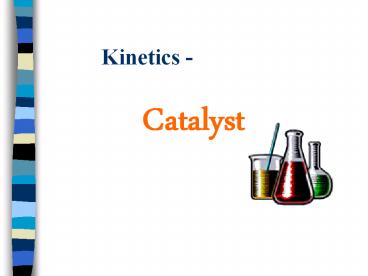Kinetics - Catalyst - PowerPoint PPT Presentation
1 / 19
Title:
Kinetics - Catalyst
Description:
Kinetics - Catalyst Definition of Catalyst A substance that alters the reaction rate of a particular chemical reaction chemically unchanged at the end of the reaction ... – PowerPoint PPT presentation
Number of Views:172
Avg rating:3.0/5.0
Title: Kinetics - Catalyst
1
Kinetics - Catalyst
2
Definition of Catalyst
- A substance that alters the reaction rate of a
particular chemical reaction - chemically unchanged at the end of the reaction
- 2 classes I) positive catalyst gt increase
the rate II) negative catalyst (inhibitor) gt
decrease the rate - How to change the rate of reaction???
3
- By providing an alternative pathway (or
mechanism) with lower/ higher activation energy.
4
- For example,Ea for the pathway with catalyst
ltEa for the pathway without catalyst
5
- The reaction can then be speeded up by increasing
the fraction of molecules that have energies in
excess of the Ea for a reaction.
Kinetic energy
Ea1
6
Exercise
- H2 and O2 mixed at room temperaturegt no
reactionaddition of small amount of Pt
powdergt violent reaction - a) What is the role of Pt?
- Catalyst
- b) What is the effect of Pt on the enthalpy
change to the reaction between H2 and O2? - No change
7
- What is the effect of Pt on the activation energy
of the original pathway? - No change
- What is the effect of Pt on the activation energy
in the reaction? - Give another pathway with lower activation
energy
8
Types of Catalyst
- 1. Heterogeneous Catalyst
- - catalyst with different phase as the
reactant - - usually solid state e.g. decomposition of
H2O2 with MnO2 as catalyst - e.g. hydrogenation of ethene (Ni as catalyst)
9
- - provides an active reaction surface for
reactant gt reaction occurs with a lower Ea - - are usually transition metal such asPt, Pd,
V2O5 and Ni
10
- 2. Homogeneous Catalyst
- - catalyst with the same phase as the reactant
- - usually in aqueous state
- e.g. Oxidation of I- ion by S2O32- with Fe3
ion as catalyst - 2I- S2O82- gt I2 2SO42-
- -------------------------------------------
- 2I- 2Fe3 gt 2Fe2 I2
- 2Fe2 S2O82- gt 2Fe3 2SO42-
11
- 3. Autocatalysis
- - the product in the reaction be the catalyst
of the reaction - - this product is called autocatalyst
- - e.g. 2MnO4- 16H 5C2O42- gt 2Mn2
8H2O 10CO2
12
Application of Catalysts
- A) Usage of Catalysts in Chemical Industries
- Cost is always the greatest concerns of
manufacturers - How can we get the highest yield of product?
13
The Cost is Very High!!
14
- Haber Process3H2 N2 gt 2NH3 (Fe)
- Contact Process2SO2 O2 gt 2SO3 (Pt/V2O5)
- Hydrogenation of CC(hardening of oil -
vegetable oil to margarine)CH2CH2 H2 gt
CH3CH3 (Ni/Pd/Pt)
15
- B) Catalytic Converters in Car Exhaust
Systems - Convert CO, NOx hydrocarbons to harmless
substances - Catalyst are coated on a honeycomb gt to
increase the surface are
16
- 3 Kinds of Catalysts
Rhodium (Rd)
Platinum (Pt)
Palladum (Pd)
17
Air Pollution
- Take care our environment - Relief the problem
of air pollution
Environmental Department
Test for the car exhaust
18
Rhodium
- Catalyses the reduction of nitrogen oxides
- and the oxidation of carbon monoxide
N2
NO
Rd
CO2
CO
19
Platinum or Palladium
Catalyses the oxidation of CO and hydrocarbons
Pt/Pd
Pt/Pd
20
Biological Catalysts - Enzymes
21
Further Exercise
- Download some more exercise from the following
web-site - http//nitec.dcu.ie/chemlc/CAL2.html

